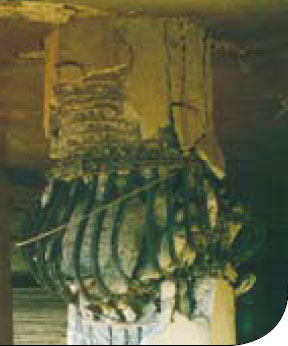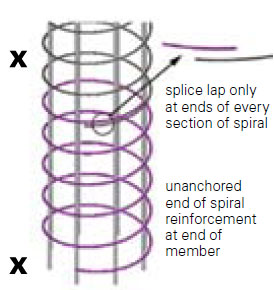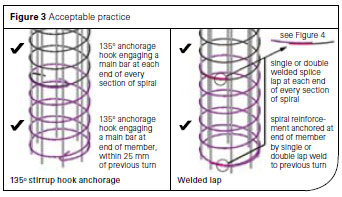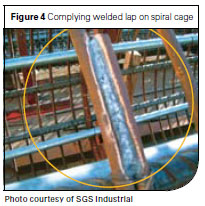Practice Advisory 8: Don’t be undone – anchor your spiral
It is essential for spiral reinforcing to be anchored and spliced properly to ensure it doesn't unravel under seismic conditions. We have provided technical guidance to help you understand how to strengthen columns and piles to prevent structural failure.
This information was confirmed as current in December 2016.
This Practice Advisory is issued as guidance information in accordance with section 175 of the Building Act 2004 and, if used, does not relieve any person of the obligation to consider any matter to which the information relates according to the circumstances of the particular case. This document is not a compliance document in terms of the Act and not a substitute for professional advice.
Issues of concern
Spiral reinforcing in circular columns and piles is not being anchored or properly spliced in many cases.
It is essential that every section of spiral reinforcement and each circular hoop in these elements is properly anchored at each end.
Inadequate anchorage or splicing can cause the spiral reinforcing to unravel under seismic conditions resulting in:
- loss of confinement to principal (longitudinal) reinforcement and core concrete
- premature and brittle failure of the element
- failure of the whole structure.
Figure 1 shows what can happen if the spiral is not properly anchored to provide continuous confinement. Figure 2 shows unacceptable practice where no anchorage is provided and just a lap is provided between sections of spiral. Laps are ineffective, especially after cover concrete spalls.

Source: Photo courtesy of the New Zealand Society for Earthquake Engineering Reconnaissance Team Northridge 1994

Don't
- pour concrete before verifying that every section of spiral reinforcement and each circular hoop is properly anchored and spliced at each end
- substitute Grade 500 steel for Grade 300 steel unless the design engineer has approved it
- allow reinforcement to be welded by unqualified welding personnel
- weld spirals/hoops to main bars
- specify or use Grade 500E QTR (quenched and tempered) spiral reinforcement if further fabrication processes are likely to involve re-bending, heating, welding or threading.
Do's
- recognise that effective confinement is vital for structural integrity
- specify the anchorage and splice requirements for spiral reinforcement clearly and fully
- check the requirements have been met on site
- provide an effective anchorage and splice for spiral reinforcement if nothing is specified
- Where a hook is used:
- do form anchorage hooks to 135° and to the correct bend diameter.
- Where a welded splice is used:
- do use a weldable grade of reinforcing for welded splices (for example, Grade 300. If using Grade 500 microalloy ensure proper welding procedure is used)
- do provide a welded anchorage or splice in accordance with AS/NZS 1554.3
- do ensure the welding personnel and procedures are qualified.
- Where mechanical connectors are used:
- do verify that mechanical connector splices meet the strength and stiffness requirements of NZS 3101
- do ensure that cover requirements are not compromised by the use of mechanical connectors
Acceptable practice
Acceptable methods of anchorage and grades of reinforcing are given in NZS 3101 and NZS 3109.
These standards require that anchorage is effected by one of the following.
- A 135° hook
- A welded lap splice
- A mechanical connector
Figures 3 and 4 show what is acceptable practice.
135° hooks
If this option is chosen, NZS 3101 requires that spiral hoops be anchored or spliced by terminating both ends of every section of spiral and every circular hoop with at least a 135° stirrup hook, engaging a longitudinal bar.
Welded lap
NZS 3101 specifies that spiral hoops may be anchored or spliced by welding to the previous spiral turn to develop the breaking strength of the bar. The requirements for lap welds are given in AS/NZS 1554.3. To prevent an early failure of the anchorage, it is essential that there is no undercut or other reduction in cross section of the spiral or hoop. Low hydrogen electrode welding and gas-shielded welding are commonly used on construction projects. It is essential that these electrodes are heated and dried before use, and that gas-shielded welding is not carried out in windy conditions. Care must be taken to ensure the principal reinforcement is not affected by the welding operation.
Mechanical connectors
There are a number of proprietary mechanical devices available for anchoring or splicing spiral and circular hoops. It is vital that the strength and stiffness performance of mechanical connectors is verified before use. Placement of mechanical connectors must not reduce cover requirements.


References
- NZS 3109 Concrete Construction, Standards New Zealand
- NZS 3101 Concrete Structures, Standards New Zealand
- AS/NZS 1554.3 Welding of Reinforcing Steel, Standards New Zealand
- AS/NZS 4671 Steel Reinforcing Materials, Standards New Zealand